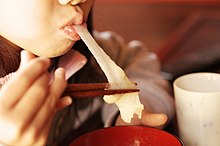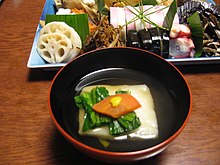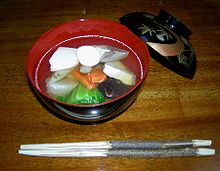99:
114:
40:
125:
84:
380:
is used instead of mochi. This type of zōni is found on some islands or mountainous areas where rice is not grown to a large extent.
248:, among other ingredients. It is also generally believed that this original meal, at first exclusive to samurai, eventually became a
639:
205:" or "boil", it is thought that the word is derived from the fact that zōni consists of many miscellaneous items of food (such as
644:
471:
148:
444:
peel for its citrus fragrance. Regional specialties are often added. A sprinkle of seven-spice chili flakes (
98:
217:) being boiled together. Formerly, amongst samurai society, the dish was referred to as "烹雑" (Hōzō) with
237:
society cuisine. It is thought to be a meal that was cooked on field battles, boiled together with
476:
446:
337:
372:, a round mochi is popular, but grill-boil difference changes depending on area. In some areas
364:
are cut into squares and grilled before being added to the stock. In the Kansai region and the
466:
365:
270:
184:
166:
87:
333:
266:
401:
113:
291:
341:
633:
369:
321:
309:
416:
305:
254:
161:
70:
585:
393:
249:
360:
for the dish also varies by region. In the Kantō region and Tōhoku region, the
175:
ceremonial foods. The preparation of zōni varies both by household and region.
258:), and thus is thought to have been a considerably important meal to samurai.
245:
210:
252:
of the common people. Zōni was first served as part of a full-course dinner (
406:
317:
241:
202:
39:
524:
124:
83:
460:
430:
397:
17:
425:
411:
389:
345:
325:
234:
214:
218:
198:
194:
171:
118:
584:[O-zōni cultural zones map throughout Japan] (in Japanese).
579:
313:
300:
287:
206:
189:
123:
112:
97:
60:
440:
421:
377:
373:
329:
156:
50:
368:, a round, boiled mochi is generally preferred. In most of the
269:(1336–1573). The dish was offered to the gods in a ceremony on
608:
551:
499:
221:
also being an archaic term for "to simmer" or "to boil".
165:
rice cakes. The dish is strongly associated with the
66:
56:
46:
197:means "miscellaneous" or "mixed", and the second,
140:
8:
438:and carrot flakes for colour; and flakes of
30:
494:
492:
265:on New Year's Day dates to the end of the
29:
336:is made with a stock of red miso. In the
286:Zōni has numerous regional variations in
546:
544:
488:
294:, zōni consists of a clear soup called
574:
572:
558:(in Japanese). Tokyo: Shogakukan. 2012
506:(in Japanese). Tokyo: Shogakukan. 2012
603:
601:
388:Common additions to the soup include
328:, zōni is made with a stock of white
7:
450:) is sometimes added at the table.
25:
472:List of Japanese soups and stews
290:. In many regions including the
82:
38:
55:
1:
193:characters. Since the first,
332:, while zōni in the part of
661:
308:made from flakes of dried
615:. Tokyo: Shogakukan. 2012
141:
77:
37:
640:Japanese soups and stews
580:
525:
298:which is flavoured with
261:The tradition of eating
645:Japanese New Year foods
356:The preparation of the
183:Zōni is written in the
132:
121:
110:
613:Encyclopedia of Japan
556:Nihon Kokugo Daijiten
344:region, a variety of
169:and its tradition of
127:
116:
101:
477:List of rice dishes
233:finds its roots in
34:
348:is used for zōni.
133:
122:
111:
504:Dijitaru daijisen
467:Japanese New Year
185:Japanese language
167:Japanese New Year
147:, often with the
96:
95:
16:(Redirected from
652:
624:
623:
621:
620:
605:
596:
595:
593:
592:
576:
567:
566:
564:
563:
548:
539:
538:
536:
534:
521:
515:
514:
512:
511:
500:"美保湾 (Miho-wan)"
496:
402:leafy vegetables
334:Fukui Prefecture
267:Muromachi period
229:It is said that
155:, is a Japanese
146:
144:
143:
86:
67:Main ingredients
42:
35:
33:
21:
660:
659:
655:
654:
653:
651:
650:
649:
630:
629:
628:
627:
618:
616:
607:
606:
599:
590:
588:
582:
578:
577:
570:
561:
559:
550:
549:
542:
532:
530:
527:
523:
522:
518:
509:
507:
498:
497:
490:
485:
456:
386:
354:
284:
279:
227:
181:
138:
102:Eating grilled
92:
88:Media: Zōni
57:Place of origin
31:
28:
23:
22:
15:
12:
11:
5:
658:
656:
648:
647:
642:
632:
631:
626:
625:
597:
568:
540:
516:
487:
486:
484:
481:
480:
479:
474:
469:
464:
455:
452:
385:
382:
366:Chūgoku region
353:
350:
283:
280:
278:
275:
271:New Year's Eve
226:
223:
180:
177:
94:
93:
91:
90:
78:
75:
74:
68:
64:
63:
58:
54:
53:
48:
44:
43:
26:
24:
14:
13:
10:
9:
6:
4:
3:
2:
657:
646:
643:
641:
638:
637:
635:
614:
610:
604:
602:
598:
587:
583:
575:
573:
569:
557:
553:
547:
545:
541:
529:(in Japanese)
528:
520:
517:
505:
501:
495:
493:
489:
482:
478:
475:
473:
470:
468:
465:
463:
462:
458:
457:
453:
451:
449:
448:
443:
442:
437:
433:
432:
427:
423:
419:
418:
413:
409:
408:
403:
399:
395:
391:
383:
381:
379:
375:
371:
370:Kyushu region
367:
363:
359:
351:
349:
347:
346:red bean soup
343:
339:
335:
331:
327:
323:
322:Kansai region
319:
315:
311:
307:
303:
302:
297:
293:
289:
281:
276:
274:
272:
268:
264:
259:
257:
256:
251:
247:
243:
240:
236:
232:
224:
222:
220:
216:
212:
208:
204:
200:
196:
192:
191:
186:
178:
176:
174:
173:
168:
164:
163:
158:
154:
150:
137:
131:
126:
120:
115:
109:
105:
100:
89:
85:
80:
79:
76:
72:
69:
65:
62:
59:
52:
49:
45:
41:
36:
27:Japanese soup
19:
617:. Retrieved
612:
589:. Retrieved
581:日本全国お雑煮文化圏地図
560:. Retrieved
555:
531:. Retrieved
519:
508:. Retrieved
503:
459:
445:
439:
435:
429:
420:(a Japanese
415:
405:
387:
361:
357:
355:
324:and eastern
299:
296:sumashi-jiru
295:
292:Kantō region
285:
262:
260:
255:honzen ryōri
253:
238:
230:
228:
188:
182:
170:
160:
152:
135:
134:
129:
107:
103:
586:TripAdvisor
552:"Tone-gawa"
424:similar to
250:staple food
246:dried foods
159:containing
634:Categories
619:2012-05-22
591:2016-10-09
562:2012-05-22
510:2012-05-20
483:References
277:Variations
242:vegetables
211:vegetables
187:using two
73:rice cakes
533:August 8,
407:komatsuna
398:meatballs
384:Additions
320:. In the
318:soy sauce
201:, means "
179:Etymology
149:honorific
142:雑煮 or ぞうに
117:zōni and
18:Zoni soup
461:Tteokguk
454:See also
447:shichimi
434:such as
431:kamaboko
404:such as
151:"o-" as
426:parsley
417:mitsuba
412:spinach
390:chicken
338:Tottori
326:Shikoku
312:and/or
235:samurai
215:seafood
128:Hakata
609:"Zōni"
436:naruto
316:, and
310:bonito
239:mochi,
225:Origin
203:simmer
172:osechi
153:o-zōni
119:osechi
81:
362:mochi
358:mochi
352:Mochi
342:Izumo
314:kombu
306:stock
301:dashi
288:Japan
282:Stock
207:mochi
190:kanji
162:mochi
108:zōni.
106:from
104:mochi
71:mochi
61:Japan
535:2013
441:yuzu
422:herb
394:fish
378:tofu
374:taro
330:miso
304:, a
263:zōni
244:and
231:zōni
213:and
157:soup
136:Zōni
130:zōni
51:Soup
47:Type
32:Zōni
428:);
410:or
396:or
376:or
636::
611:.
600:^
571:^
554:.
543:^
526:雑煮
502:.
491:^
414:;
400:;
392:,
273:.
209:,
622:.
594:.
565:.
537:.
513:.
340:-
219:烹
199:煮
195:雑
145:)
139:(
20:)
Text is available under the Creative Commons Attribution-ShareAlike License. Additional terms may apply.







